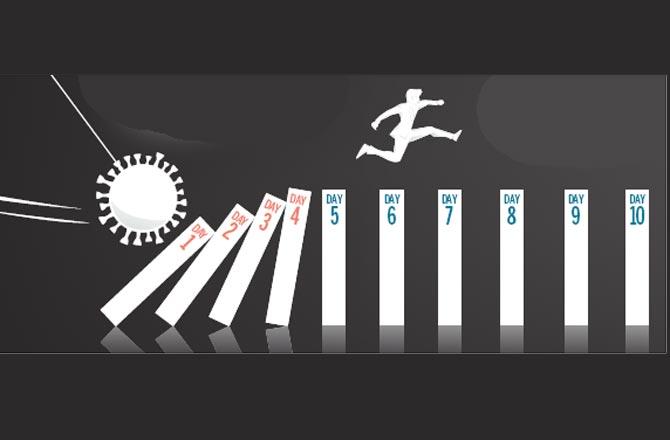Israeli systems biologists recommend a cycle of four days of work, followed by 10 days of lockdown as the middle path in the battle between beating the virus and restarting the economy

Commuters travel on a public bus during rush hour as workplaces with 10 per cent staff and non-essential shops operate again after more than two months of lockdown imposed as a preventive measure against the Coronavirus outbreak, in Mumbai. Pic/ Getty Im
Eighty three days is too long to have shut down the economy, one would argue. And yet, in the face of a highly infectious virus that has already claimed over four lakh lives across the world since being discovered in December 2019, what option do we have? The answer lies somewhere in between opening up the economy and a complete lockdown and, may be guided by how the virus operates, say Uri Alon and Ron Milo, systems biologists and professors at the Weizmann Institute of Science, Rehovot, Israel.
ADVERTISEMENT
In a TED talk that has now garnered nearly eight lakh views, Alon discusses the 4-10 strategy on exiting the lockdown. This, he says, is based on the behaviour of the novel Coronavirus: When one is infected with the virus, they are not infectious for three days and they start showing symptoms only after. So, the duo suggests that four days of work be followed by 10 days of lockdown during which people will reach peak infectiousness and avoid infecting others. "Everyone works on the same four days with measures of social distancing and masks [in place], and people with infections can self-quarantine," says Alon in the TED talk.

Quoting a paper titled Science Forum: SARS-CoV-2 COVID-19 by the numbers written by Yinon M Bar-On, Avi Flamholz, Rob Phillips, Ron Milo of the same University, Milo, in a quick FAQ handout, states that the approach was tried by the Austrian school system with a variant—five days of school every two weeks in two groups, starting May 18, 2020; Mexico city announced reopening the economy with a 4-10 cyclic strategy, beginning the second half of June 2020. Several companies have adopted the approach e.g. Mastercard, with over 10,000 employees.
On the benefits of this approach versus fully reopening the economy, he says: "The risk of a second wave of the epidemic is higher when fully reopening the economy. In the right conditions, the cyclic strategy can prevent a second wave that will necessitate going back to full lockdown. In some cases, the cyclic strategy can provide workers more confidence to return to work [more protection from infection from co-workers] than a full reopening. This was found, for example, in a hospital ward that used a cyclic strategy with several groups."

Ron Milo
The biologist says that the infectious period is shorter than the overall duration of illness, which lasts a few weeks for those with severe symptoms. "People usually stop being strongly contagious well before they recover from the disease. Moreover, severe and moderate cases are hospitalised or quarantined at home, and thus away from work. After 10 days, most people are much less infectious." Of course, those who show symptoms of COVID-19 should stay in quarantine or isolation until recovered.
Milo says that they recommend an initial phase of two cycles, i.e. one month after which the situation can be assessed. The approach is adaptive, and so is based on monitoring of cases.
Outlining the conditions for implementing the strategy, he says it-s important to understand the reproduction number of the virus in the community R. The reproduction number is the number of people that one infected person will pass the virus on to, on average. While the 4-10 strategy was designed to be used when the R under lockdown is well below 1—they give the example of many countries in Europe in May 2020 when R equalled 0.6-0.8—and that R during work days is reduced from initial 3-4 to 1.5 or below "thanks to measures including physical distancing, masks and self-quarantine upon symptoms. These conditions seem to apply, for example, in many European countries".
However, he cautions that those who can, should still continue working from home. "In a way they are helping those that do not have that freedom and must work out of the house," says the statement, adding that people in high risk groups should follow health authority recommendations.
Catch up on all the latest Mumbai news, crime news, current affairs, and a complete guide from food to things to do and events across Mumbai. Also download the new mid-day Android and iOS apps to get latest updates.
Mid-Day is now on Telegram. Click here to join our channel @middayinfomedialtd and stay updated with the latest news
 Subscribe today by clicking the link and stay updated with the latest news!" Click here!
Subscribe today by clicking the link and stay updated with the latest news!" Click here!






